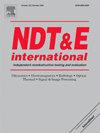数据驱动的声信号深度表示提高了硬币敲击检测的准确性,用于无损检测缺陷
IF 4.5
2区 材料科学
Q1 MATERIALS SCIENCE, CHARACTERIZATION & TESTING
引用次数: 0
摘要
硬币抽头检测是一种简单的缺陷无损检测方法,在工程结构中应用已久。然而,提高硬币敲击测试的准确性是一个挑战。在这项工作中,我们提出了一种数据驱动的声信号深度表示方法,以提高硬币敲击测试的准确性。我们设计了一个具有两个特征聚合块的增量密集一维卷积神经网络(IDCNN)来组织深度表示。我们将六种缺陷引入到三种双层结构中,使用硬币敲击测试获得声信号,并训练IDCNN。结果表明,该方法能较好地表征声信号的深度,显著提高了硬币敲击测试的精度。缺陷检测的准确率从98.42%到99.06%不等。缺乏率和错误警报率非常低,分别从0.94%到1.58%和从0.72%到1.32%。结果表明,基于数据驱动的声信号深度表示方法能够有效地实现对缺陷的无损检测。该方法在基于声学的无损检测中具有广泛的应用前景。本文章由计算机程序翻译,如有差异,请以英文原文为准。
Data-driven deep representation of acoustic signals amplifies the accuracy of coin-tap test for non-destructive detection of defects
Coin-tap test is a simple way for non-destructive detection of defects, and has long been used in engineering structures. However, improving the accuracy of coin-tap test is challenging. In this work, we propose a data-driven deep representation method for acoustic signals to amplify the accuracy of coin-tap test. We design an incremental dense one-dimensional convolutional neural network (IDCNN) with two feature aggregation blocks to organize deep representations. We introduce six types of defects to three types of bi-layered structures, use coin-tap tests to obtain acoustic signals, and train the IDCNN. The results show that the IDCNN performs well for deep representation of acoustic signals and significantly amplifies the accuracy of coin-tap test. The accuracy rate for defect detection ranges from 98.42 % to 99.06 %. The rates of missing and false alarms for defects are extremely low, ranging from 0.94 % to 1.58 % and from 0.72 % to 1.32 %, respectively. The results show that the data-driven deep representation of acoustic signals results in an effective coin-tap test for non-destructive detection of defects. The proposed method has potential for broad applications in acoustic-based non-destructive tests.
求助全文
通过发布文献求助,成功后即可免费获取论文全文。
去求助
来源期刊

Ndt & E International
工程技术-材料科学:表征与测试
CiteScore
7.20
自引率
9.50%
发文量
121
审稿时长
55 days
期刊介绍:
NDT&E international publishes peer-reviewed results of original research and development in all categories of the fields of nondestructive testing and evaluation including ultrasonics, electromagnetics, radiography, optical and thermal methods. In addition to traditional NDE topics, the emerging technology area of inspection of civil structures and materials is also emphasized. The journal publishes original papers on research and development of new inspection techniques and methods, as well as on novel and innovative applications of established methods. Papers on NDE sensors and their applications both for inspection and process control, as well as papers describing novel NDE systems for structural health monitoring and their performance in industrial settings are also considered. Other regular features include international news, new equipment and a calendar of forthcoming worldwide meetings. This journal is listed in Current Contents.
 求助内容:
求助内容: 应助结果提醒方式:
应助结果提醒方式:


